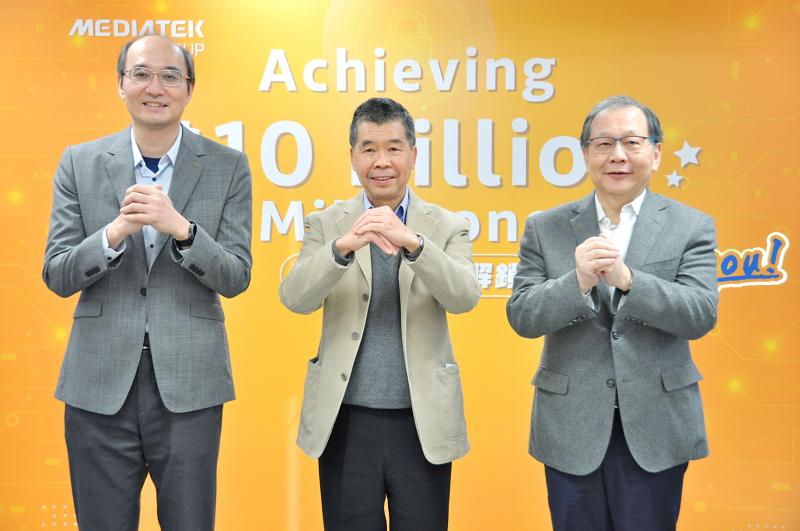MediaTek Inc (聯發科) yesterday announced it would give incentive bonuses totaling NT$1.7 billion (US$59.7 million) to its employees and those at the firm’s major subsidiaries, after the smartphone chip supplier’s revenue hit US$10 billion last year.
This is the biggest incentive bonus the Hsinchu-based handset chip designer has ever distributed in its 23-year history.
About 17,000 full-time employees of MediaTek and five of its subsidiaries, including Richtek Technology Corp (立錡科技) and Airoha Technology Corp (絡達科技), would receive a “red envelope” of NT$100,000 each, the company said.

Photo courtesy of MediaTek Inc
“Surpassing US$10 billion is just the beginning. We will continue to [grow] on this basis,” MediaTek said in a statement.
MediaTek, which has about 10,000 employees in Taiwan, said it has also allocated 20 percent of its annual distributable earnings for local employees’ year-end bonuses.
MediaTek posted NT$322.15 billion in consolidated revenue last year, up 30.84 percent from NT$246.22 billion in 2019, a record for the company, as its 5G smartphone chips were adopted by a growing number of vendors.
LG Electronics Co and Chinese smartphone vendors, including Realme Mobile Telecommunications (Shenzhen) Co (銳爾覓移動通信), Xiaomi Corp (小米), Vivo Communication Technology Co (維沃) and Oppo Mobile Telecommunications Corp (歐珀), use MediaTek’s 5G Dimensity chips in their latest handsets.
MediaTek last quarter overtook Qualcomm Inc as the world’s biggest smartphone chipset supplier for the first time, as its affordable chips gained traction in emerging markets, a tally by market researcher Counterpoint showed.

Taiwan Semiconductor Manufacturing Co (TSMC, 台積電) last week recorded an increase in the number of shareholders to the highest in almost eight months, despite its share price falling 3.38 percent from the previous week, Taiwan Stock Exchange data released on Saturday showed. As of Friday, TSMC had 1.88 million shareholders, the most since the week of April 25 and an increase of 31,870 from the previous week, the data showed. The number of shareholders jumped despite a drop of NT$50 (US$1.59), or 3.38 percent, in TSMC’s share price from a week earlier to NT$1,430, as investors took profits from their earlier gains

In a high-security Shenzhen laboratory, Chinese scientists have built what Washington has spent years trying to prevent: a prototype of a machine capable of producing the cutting-edge semiconductor chips that power artificial intelligence (AI), smartphones and weapons central to Western military dominance, Reuters has learned. Completed early this year and undergoing testing, the prototype fills nearly an entire factory floor. It was built by a team of former engineers from Dutch semiconductor giant ASML who reverse-engineered the company’s extreme ultraviolet lithography (EUV) machines, according to two people with knowledge of the project. EUV machines sit at the heart of a technological Cold

CHINA RIVAL: The chips are positioned to compete with Nvidia’s Hopper and Blackwell products and would enable clusters connecting more than 100,000 chips Moore Threads Technology Co (摩爾線程) introduced a new generation of chips aimed at reducing artificial intelligence (AI) developers’ dependence on Nvidia Corp’s hardware, just weeks after pulling off one of the most successful Chinese initial public offerings (IPOs) in years. “These products will significantly enhance world-class computing speed and capabilities that all developers aspire to,” Moore Threads CEO Zhang Jianzhong (張建中), a former Nvidia executive, said on Saturday at a company event in Beijing. “We hope they can meet the needs of more developers in China so that you no longer need to wait for advanced foreign products.” Chinese chipmakers are in

AI TALENT: No financial details were released about the deal, in which top Groq executives, including its CEO, would join Nvidia to help advance the technology Nvidia Corp has agreed to a licensing deal with artificial intelligence (AI) start-up Groq, furthering its investments in companies connected to the AI boom and gaining the right to add a new type of technology to its products. The world’s largest publicly traded company has paid for the right to use Groq’s technology and is to integrate its chip design into future products. Some of the start-up’s executives are leaving to join Nvidia to help with that effort, the companies said. Groq would continue as an independent company with a new chief executive, it said on Wednesday in a post on its Web